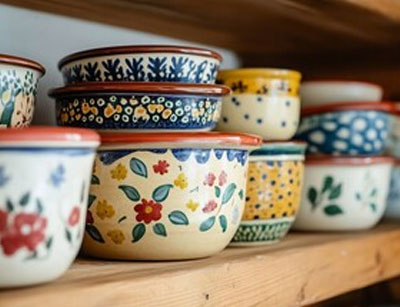
Traditional ceramic dishware is beautiful and brings the culture and art of Mexico, China, and of other places into your home. However, some dishware may contain harmful lead. Due to the challenge of identifying pots or dishes with lead, exercise caution when using traditional ceramic dishware for cooking, serving, or storing food and beverages.
If you use traditional pottery:
- Test it for lead. You can buy lead test kits at hardware stores. Even if the test shows that your pottery does not have lead, test again if it becomes worn, chipped, or cracked.
- If it has lead or you don’t know, do not use it for cooking, serving or storing food and drinks. Instead, you can use it as a decoration.
Tips for Using Ceramic Dishware
How can I find out if my dishware is safe?
To determine if dishware meets California Proposition 65 regulations for lead, inquire at the store, contact the manufacturer, or use test kits. Lab testing is the only way to know the exact lead content, but it can be costly and damage the dish. Color-change test kits from hardware stores can indicate lead presence, but not the amount. If positive, avoid using the dish for food or drinks; however, a negative result does not guarantee safety.
Is there a way to remove lead from my ceramic dishware?
No. Many people use various traditional methods to “cure” dishware believing that it will also remove the lead. Some methods include boiling the dishware in water or in water with an acidic substance (e.g., vinegar or lemon), washing the dishware with bleach, and rubbing it with garlic and salt. These traditional “curing” methods will not eliminate lead in dishware.
Why is there lead in some ceramic dishware?
Lead can be in the glaze or painted decoration of ceramic dishware. Glaze makes dishware smooth and shiny, and makes some colors brighter. You cannot see lead in the glaze or paint. Even if the dishware isn’t decorated, the glaze may have lead.
How does lead get from dishware into your body?
Improperly manufactured ceramic dishware can lead to lead leaching into food or drinks, especially acidic ones, even without visible wear. This can result in lead entering the body, posing health risks.
What kinds of ceramic dishware are more likely to have lead?
- Highly decorated traditional dishware from Mexico, China, and other places.
- Dishware that is old, worn, chipped, or cracked.
- Dishware made by small-scale artisans, especially those located outside the U.S.
- Dishware sold by street vendors or at flea markets.
My relatives and friends have been using this type of dishware for years. Why hasn’t anyone gotten sick?
Lead can cause serious health problems. But most children who are poisoned by lead do not look or act sick. The only way to know if your child has lead poisoning is to get a special blood test for lead. The test is free or low cost.
Are there any laws against selling dishware that has lead?
US FDA (Food and Drug Administration) has laws about lead in ceramic dishware. California has an even stricter law requiring that ceramic dishware that has lead must have a special “Proposition 65” warning.